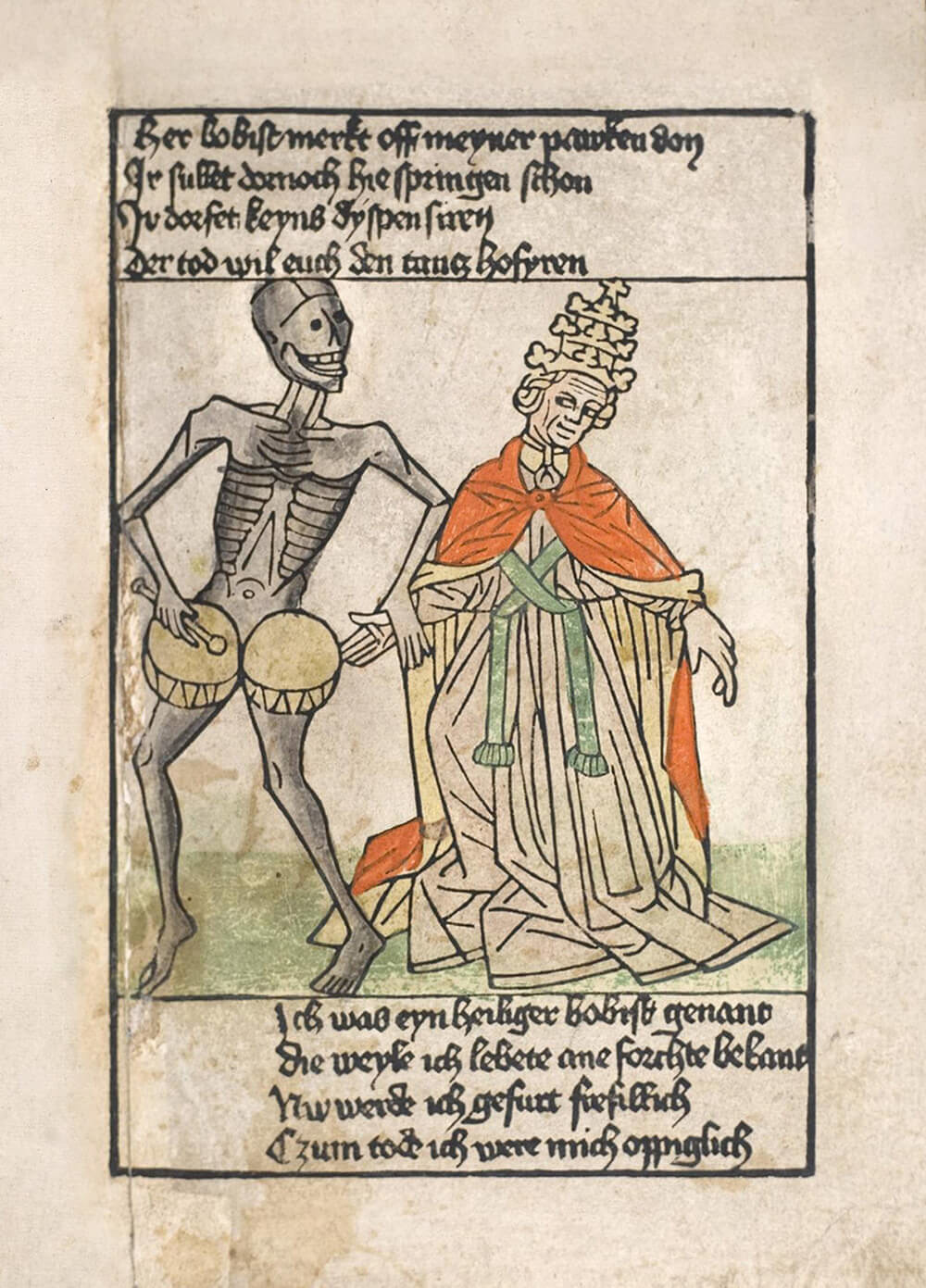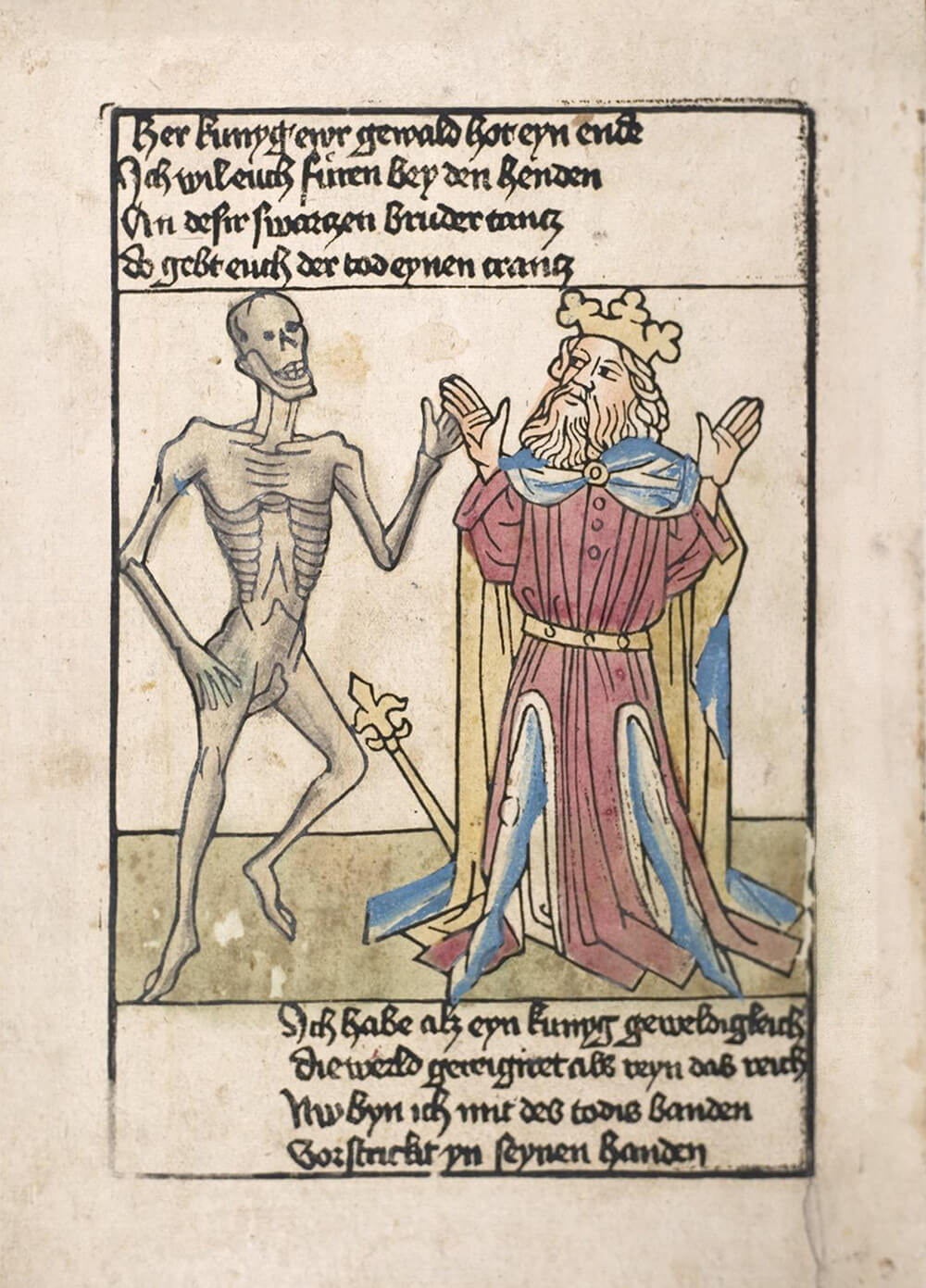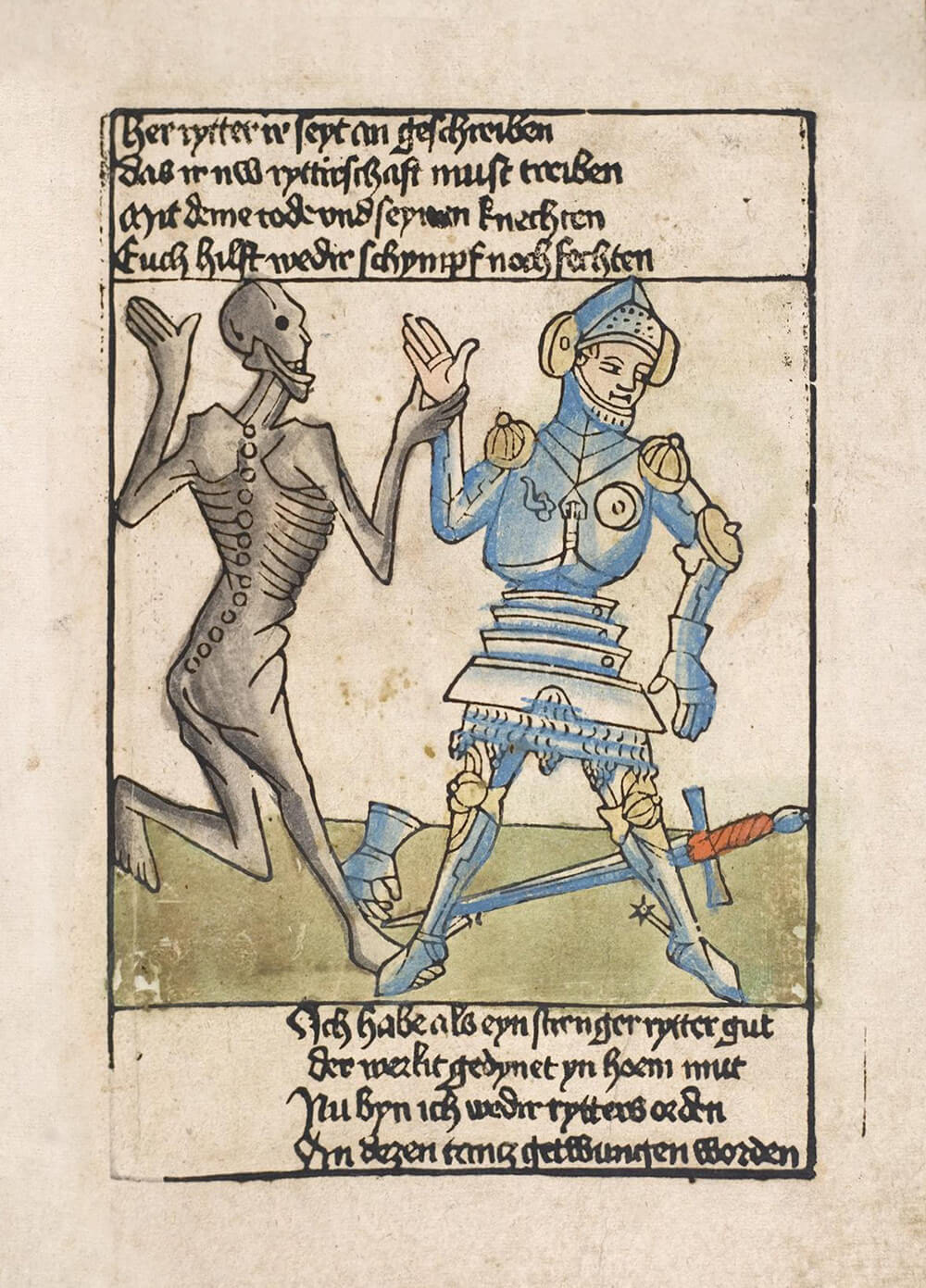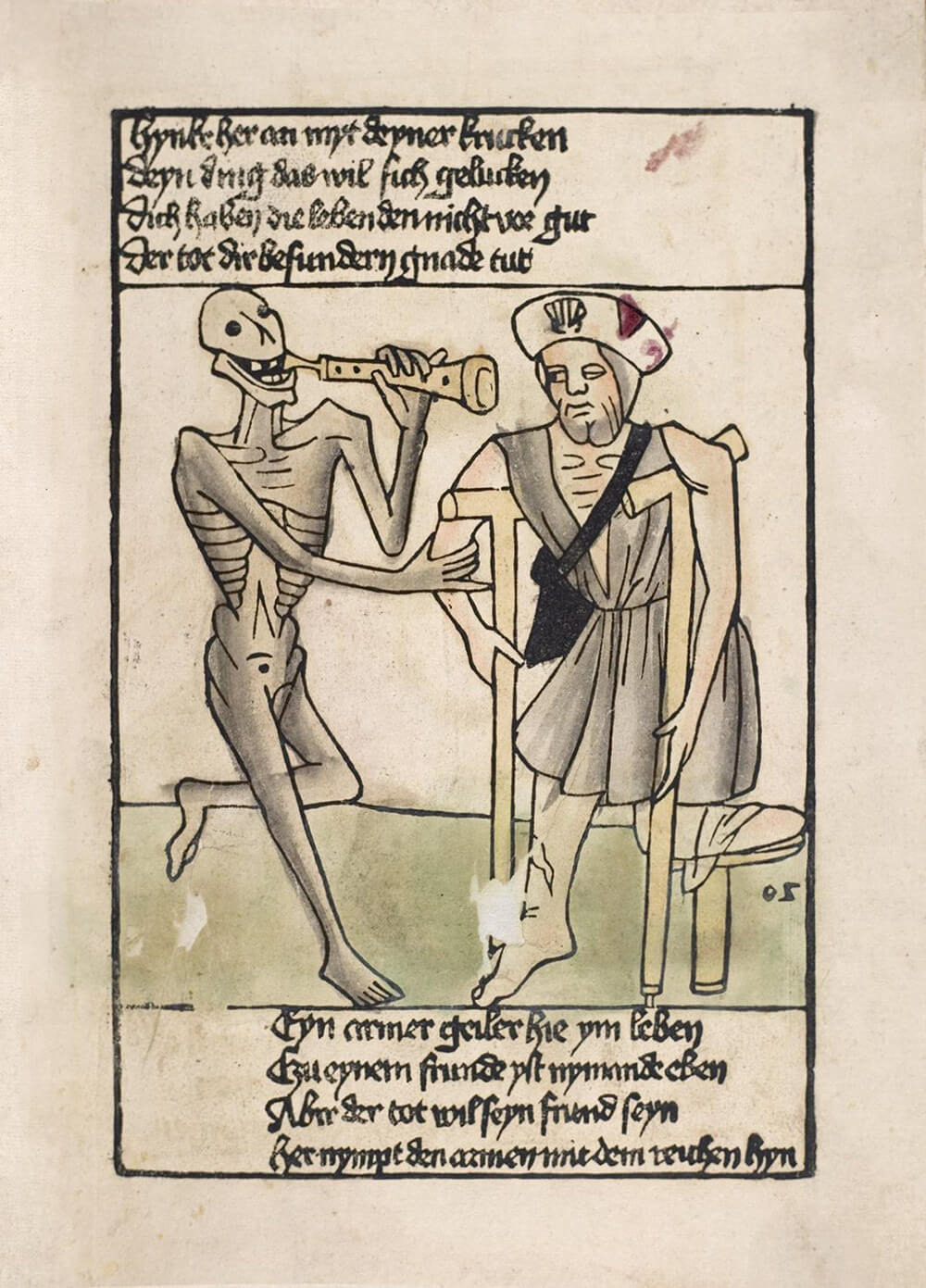The Apostate
June 2023 >> Index
another work-in-progress logotype
Played around with a new logotype, which I like— particularly the symmetry above and below the letter S. The woman is likely a suggestion of some future sketch or photography.
From the onset, I’ve wanted to ground my Joan play in medieval life. So, I’ve been researching various attitudes and artistic expressions of her era.
Plague, War, Famine, Death. An apocalyptical landscape— physical and spiritual.
To that end— this month I researched the Danse Macabre— a French creation— which is a bit of art, a bit of allegory— it's about the universality of death, how it awaits everyone, regardless of social class— "Don’t worry everybody, those nobles are gonna end up feeding the worms, too!"
Folks would cosplay as representatives of each social class— starting with The Pope and ending with The Beggar— they would sing a little song with Death and then do a little dance. Dark humor makes this otherwise gruesome prospect actually a good-time memento mori.
So, I have a troupe performing a truncated version of a longer pageant. This closes out Act I, interspersed with other dialogue and action, as Joan meets Jean de Metz for the first time.
Of the many Danse Macabre iterations, I gravitate towards its presentation in the Totentanz Blockbook— my key inspiration. The oldest surviving printed version of the Danse Macabre, this book is from 1455-ish, author unknown.
• Totentanz: German: toten ≈ “kill” and tanz ≈ “dance.” Together, totentanz ≈ “dance of death.”
• Blockbook: Carved woodcuts block printed in the 15th Century, they included text and illustrations.
Each illustration contains a different character's dialogue with Death— a total of twenty-six illustrations record the dance. The narrative is in German.
Here are a few sample pages from the Totentanz Blockbook.






Left to right: the Pope, the King, the Knight, the Merchant, the Peasant, the Beggar. The Knight’s proportions give him an almost animatronic appearance.
You can page through the entire Totentanz Blockbook here— courtesy of Heidelberg University.
In my version, I’m writing the dialogues with Death in couplets, adapting the Danse Macabre form to reflect the characters in my play.
The representations I’ve chosen are: Death, The Pope, The King, The Duke, The Knight, The Tax Collector (changed from The Merchant), The Farm Girl (changed from The Peasant), The Beggar, and The Poet (changed from The Physician). Doubtless, I will have to limit the number of participants in the actual play, but I've written dialogue for each.
I changed The Farm Girl from The Peasant because I want the The Farm Girl dressed as Joan from the first scene— which her brother Pierre will notice but Joan will dismiss. The Farm Girl’s couplets will match Joan’s point-of-view.
I changed The Poet from The Physician and placed The Poet last (at the bottom of the medieval hierarchy) for some obvious self-depreciating humor. Sorry.
When I started, I thought Death would first do his double couplet, and then his dance partner would do theirs in response— like this:
—but now I am thinking— how fun to alternate couplets, much more jolly, dancin’ ‘round, frolicking and whatnot— try it out, sing this outloud with someone—
If you’re curious about that last line (which I don’t think quite works yet)— check out this neat website— Medieval Dance Online— and their page about the carole, the French dance referenced in the song.
Related overall to this play— recently I went looking for a used copy of Mother Courage and Her Children and found this amazing book— which I expect to help me with The Apostate— a five-dollar-ish first edition of The Royal Shakespeare Company's Centenary Production of Henry V by Sally Beauman.
This production, as it says on the tin, was the 100th produced at the RSC. Directed by Terry Hands in 1975, it starred Alan Howard as Henry.
Here’s a few pics:



The book includes costume sketches by Abdel Farrah and production photos by Nobby Clark of Joe Cocks Studios.
Through interviews with the cast and crew we get glimpses into the RSC putting on my favorite Shakespeare play— as well as the text used in this particular production. Footnotes explain which lines were dropped or altered and why. Pretty cool.
In my fantasies, The Apostate would be a good pairing with Henry V. I swear this isn’t a hubristic suggestion. It may sound like it. I just think it’d be an interesting storytelling juxtaposition.
Perhaps a theatre could do Henry on a Friday and then Joan the next day, Saturday. This would swing the audience around from one side of the same conflict to the other. Something of a linear journey as well— as Joan was a toddler (born c1412) and about a three day walk away when Henry called for Non Nobis and Te Deum on French soil (The Battle of Agincourt— October 25, 1415).
Not to mention, the back-to-back stories might be me, gasping and blinking in shock, offering a counterpoint to Shakespeare’s unkind portrayal of Joan in Henry VI Part One. What was he thinking? (Some have suggested this sullied portrayal is evidence that more than one writer is responsible for Henry VI Part One— at first blush, this sounds to me like apologizing for Shakespeare getting Joan all wrong?)
You can explore this production of Henry V on The Royal Shakespeare Company's website with production photos, a design gallery, and more.
Henry V has long been one of my inspirations— in particular, the Branagh film (my introduction to Shakespeare). Its opener is an all-time-banger, as they say, and directly influenced the exordium of my novel Valkyrie, a story which unites theatre and mythology.
Plus— c’mon— Derek Jacobi ftw.